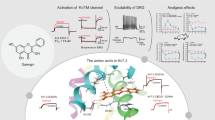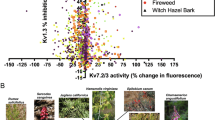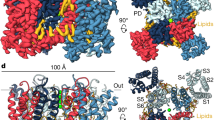Abstract
Aim:
The aim of this study was to examine the activation of neuronal Kv7/KCNQ channels by a novel modified Kv7 opener QO58-lysine and to test the anti-nociceptive effects of QO58-lysine on inflammatory pain in rodent models.
Methods:
Assays including whole-cell patch clamp recordings, HPLC, and in vivo pain behavioral evaluations were employed.
Results:
QO58-lysine caused instant activation of Kv7.2/7.3 currents, and increasing the dose of QO58-lysine resulted in a dose-dependent activation of Kv7.2/Kv7.3 currents with an EC50 of 1.2±0.2 μmol/L. QO58-lysine caused a leftward shift of the voltage-dependent activation of Kv7.2/Kv7.3 to a hyperpolarized potential at V1/2=-54.4±2.5 mV from V1/2=-26.0±0.6 mV. The half-life in plasma (t1/2) was derived as 2.9, 2.7, and 3.0 h for doses of 12.5, 25, and 50 mg/kg, respectively. The absolute bioavailabilities for the three doses (12.5, 25, and 50 mg/kg) of QO58-lysine (po) were determined as 13.7%, 24.3%, and 39.3%, respectively. QO58-lysine caused a concentration-dependent reduction in the licking times during phase II pain induced by the injection of formalin into the mouse hindpaw. In the Complete Freund's adjuvant (CFA)-induced inflammatory pain model in rats, oral or intraperitoneal administration of QO58-lysine resulted in a dose-dependent increase in the paw withdrawal threshold, and the anti-nociceptive effect on mechanical allodynia could be reversed by the channel-specific blocker XE991 (3 mg/kg).
Conclusion:
Taken together, our findings show that a modified QO58 compound (QO58-lysine) can specifically activate Kv7.2/7.3/M-channels. Oral or intraperitoneal administration of QO58-lysine, which has improved bioavailability and a half-life of approximately 3 h in plasma, can reverse inflammatory pain in rodent animal models.
Similar content being viewed by others
Log in or create a free account to read this content
Gain free access to this article, as well as selected content from this journal and more on nature.com
or
References
Wang HS, Pan Z, Shi W, Brown BS, Wymore RS, Cohen IS, et al. KCNQ2 and KCNQ3 potassium channel subunits: molecular correlates of the M-channel. Science 1998; 282: 1890–3.
Xiong Q, Gao Z, Wang W, Li M . Activation of Kv7 (KCNQ) voltage-gated potassium channels by synthetic compounds. Trends Pharmacol Sci 2008; 29: 99–107.
Cooper EC, Aldape KD, Abosch A, Barbaro NM, Berger MS, Peacock WS, et al. Colocalization and coassembly of two human brain M-type potassium channel subunits that are mutated in epilepsy. Proc Nat Acad Sci U S A 2000; 97: 4914–9.
Kubisch C, Schroeder BC, Friedrich T, Lütjohann B, El-Amraoui A, Marlin S, et al. KCNQ4, a novel potassium channel expressed in sensory outer hair cells, is mutated in dominant deafness. Cell 1999; 96: 437–46.
Charlier C, Singh NA, Ryan SG, Lewis TB, Reus BE, Leach RJ, et al. A pore mutation in a novel KQT-like potassium channel gene in an idiopathic epilepsy family. Nat Genet 1998; 18: 53–5.
Blackburn-Munro G, Dalby-Brown W, Mirza NR, Mikkelsen JD, Blackburn-Munro RE . Retigabine: chemical synthesis to clinical application. CNS Drug Rev 2005; 11: 1–20.
Deeks ED . Retigabine (ezogabine): in partial-onset seizures in adults with epilepsy. CNS Drugs 2011; 25: 887–900.
French JA, Abou-Khalil BW, Leroy RF, Yacubian EM, Shin P, Hall S, et al. Randomized, double-blind, placebo-controlled trial of ezogabine (retigabine) in partial epilepsy. Neurology 2011; 76: 1555–63.
Harris JA, Murphy JA . Retigabine (ezogabine) as add-on therapy for partial-onset seizures: an update for clinicians. Ther Adv Chronic Dis 2011; 2: 371–6.
Korsgaard MP, Hartz BP, Brown WD, Ahring PK, Strobaek D, Mirza NR . Anxiolytic effects of Maxipost (BMS-204352) and retigabine via activation of neuronal Kv7 channels. J Pharmacol Exp Ther 2005; 314: 282–92.
Slomko AM, Naseer Z, Ali SS, Wongvravit JP, Friedman LK . Retigabine calms seizure-induced behavior following status epilepticus. Epilepsy Behav 2014; 37: 123–32.
Blackburn-Munro G, Jensen BS . The anticonvulsant retigabine attenuates nociceptive behaviours in rat models of persistent and neuropathic pain. Eur J Pharmacol 2003; 460: 109–16.
Hirano K, Kuratani K, Fujiyoshi M, Tashiro N, Hayashi E, Kinoshita M . Kv7.2–7.5 voltage-gated potassium channel (KCNQ2-5) opener, retigabine, reduces capsaicin-induced visceral pain in mice. Neurosci Lett 2007; 413: 159–62.
Li H, Wang F, Wang X, Sun R, Chen J, Chen B, et al. Antinociceptive efficacy of retigabine in the monosodium lodoacetate rat model for osteoarthritis pain. Pharmacology 2015; 95: 251–7.
Pottabathini R, Kumar A, Bhatnagar A, Garg S . Possible involvement of nitric oxide modulatory mechanism in the protective effect of retigabine against spinal nerve ligation-induced neuropathic pain. Cell Mol Neurobiol 2015; 35: 137–46.
Passmore GM, Selyanko AA, Mistry M, Al-Qatari M, Marsh SJ, Matthews EA, et al. KCNQ/M currents in sensory neurons: significance for pain therapy. J Neurosci 2003; 23: 7227–36.
Kalappa BI, Soh H, Duignan KM, Furuya T, Edwards S, Tzingounis AV, et al. Potent KCNQ2/3-specific channel activator suppresses in vivo epileptic activity and prevents the development of tinnitus. J Neurosci 2015; 35: 8829–42.
Xiong Q, Sun H, Li M . Zinc pyrithione-mediated activation of voltage-gated KCNQ potassium channels rescues epileptogenic mutants. Nat Chem Biol 2007; 3: 287–96.
Davoren JE, Claffey MM, Snow SL, Reese MR, Arora G, Butler CR, et al. Discovery of a novel Kv7 channel opener as a treatment for epilepsy. Bioorg Med Chem Lett 2015; 25: 4941–4.
Qi J, Zhang F, Mi Y, Fu Y, Xu W, Zhang D, et al. Design, synthesis and biological activity of pyrazolo[1,5-a]pyrimidin-7(4H)-ones as novel Kv7/KCNQ potassium channel activators. Eur J Med Chem 2011; 46: 934–43.
Zhang F, Mi Y, Qi JL, Li JW, Si M, Guan BC, et al. Modulation of Kv7 potassium channels by a novel opener pyrazolo[1,5-a]pyrimidin-7(4H)-one compound QO-58. Br J Pharmacol 2013; 168: 1030–42.
Liu CF, Qi JL, Zhang HL, Jia QZ . Pharmacokinetic study of QO-58: a new potassium channel opener. Chin Pharmacol Bull 2014; 30: 574–7.
Ma T, Wang K . Development of high-performance liquid chromatography assay for pharmacokinetic analysis of KCNQ/M-channel opener QO58-lysin in rat plasma. J Chin Pharm Sci 2014; 23: 153–8.
Qin WJ, Wang YT, Zhang M, Wen RT, Liu Q, Li YL, et al. Molecular chaperone heat shock protein 70 participates in the labile phase of the development of behavioural sensitization induced by a single morphine exposure in mice. Int J Neuropsychopharmacol 2013; 16: 647–59.
Patchornik S, Ram E, Ben Shalom N, Nevo Z, Robinson D . Chitosan-hyaluronate hybrid gel intraarticular injection delays osteoarthritis progression and reduces pain in a rat meniscectomy model as compared to saline and hyaluronate treatment. Adv Orthop 2012; 2012: 979152.
Allen KD, Mata BA, Gabr MA, Huebner JL, Adams SB Jr, Kraus VB, et al. Kinematic and dynamic gait compensations resulting from knee instability in a rat model of osteoarthritis. Arthritis Res Ther 2012; 14: R78.
Xu W, Wu Y, Bi Y, Tan L, Gan Y, Wang K . Activation of voltage-gated KCNQ/Kv7 channels by anticonvulsant retigabine attenuates mechanical allodynia of inflammatory temporomandibular joint in rats. Mol Pain 2010; 6: 49.
Acknowledgements
This work was supported by research grants to KeWei WANG from the Ministry of Science and Technology of China (No 2013CB531302, 2013ZX09103001-015 and 2014ZX09507003-006-004) and to Jin-long QI from the Hebei Province Education Department (No YQ2013033).
Author information
Authors and Affiliations
Corresponding authors
Rights and permissions
About this article
Cite this article
Teng, Bc., Song, Y., Zhang, F. et al. Activation of neuronal Kv7/KCNQ/M-channels by the opener QO58-lysine and its anti-nociceptive effects on inflammatory pain in rodents. Acta Pharmacol Sin 37, 1054–1062 (2016). https://doi.org/10.1038/aps.2016.33
Received:
Accepted:
Published:
Issue date:
DOI: https://doi.org/10.1038/aps.2016.33
Keywords
This article is cited by
-
TET1 Participates in Complete Freund’s Adjuvant-induced Trigeminal Inflammatory Pain by Regulating Kv7.2 in a Mouse Model
Neuroscience Bulletin (2023)
-
Flupirtine and antihistamines exert synergistic anti-nociceptive effects in mice
Psychopharmacology (2023)



